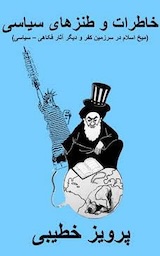Cartoon by Mohammad Yavari
Women In Iran Uniting Against Gender And Political Oppression
By Majid Mohammadi
Iran International: As Iranian women continue to defy the Islamic government in Tehran by shunning the hijab in ever-greater numbers, officials cling to the theory of foreign conspiracies to justify their crackdown.
“Foreign meddling” seeks to bring about a change of the political system in Iran by using “women as a tool within the framework of a so-called opposition,” Hossein Amir-Abdollahian, the Islamist regime’s foreign minister said in an interview with CNN in response to a question about increasing pressure on Iranian women to impose the hijab.
Iran's ruler, Ali Khamenei has repeatedly denounced women opposing the imposition of Islamic practices on their chosen way of life, even branding them as enemies: "Removing the hijab is by sharia and politically forbidden... however... the enemy entered this business with a roadmap and a plan; we must also enter with a roadmap and a plan."
Do Iranian women possess the potential to be a viable opposition? How does Khamenei perceive “the enemy's” strategy? What strategy do women employ when confronting a government that views them as adversaries?
The potential for women to become an opposition force
Iranian women have a high capacity to spearhead the opposition to the Islamist regime. Although more than half of the university student population are women, their share in the Iranian labor market is about 14%. The share of Iranian women in the country's top management is less than 6%.
In terms of rights violations, women face the most structural and legal infringements after the Baha'i religious community. These violations span from family and education to employment and public service, encompassing human rights abuses and denying equal opportunities. Hence, there's no necessity for "foreign enemies" to provoke women into opposition; their circumstances and oppressions necessitate it.
The women's movement against the violation of their fundamental rights stands as the most active anti-government social movement today. In contrast, other movements like labor, retirees, and teachers’ movements, while significant, are less directly targeted at the government, Shia Islamism, and Shia clergy.
“Enemy’s plan”
When Ali Khamenei talks about the enemy's plan, he means any action that challenges the regime, including not observing the hijab. He believes any challenge is organized and directed by foreign enemies. This attitude also has a practical aspect: when the opposition is rooted abroad, its suppression with coercive forces becomes legitimate, and women who commit civil disobedience should be treated as foreign agents.
In April 2024, the government launched a new hybrid war against women. The following methods are used in this war:
1. Deploying shockers to incapacitate women who protest verbally and behaviorally or resist arrest;
2. Throwing blankets over women’s heads during their arrest for hijab violation;
3. Deploying plainclothes agents next to the special police units to prevent the protest of passers-by;
4. Insulting and verbally humiliating women and sexually harassing them during detention;
5. Deploying formidable agents with obscured faces to enhance intimidation; and
6. Displaying street banners that equate hijab with morality and religiosity.
In this operation, women are arrested with minimal resistance. The latest crackdown on women is no longer carried out by regular morality police or patrols; it involves a special police unit.
Protesting women's plan
Today, the Iranian women's movement against Islamist totalitarianism, which has persisted through fluctuations over the past 45 years, exhibits three key characteristics:
A. Nationwide networking. Iranian women activists are connected in a nationwide network. This network includes three social groups: 1) Former and current women prisoners who have been persecuted simply because of their beliefs or expressing their opinions. Their number has risen to thousands in the last decade, 2) Bereaved wives, mothers, and sisters whose children, brothers and husbands were killed or executed by the government and who themselves spent a period in prison for demanding justice; and 3) women who have been active in labor, student, teacher, environmental and retirees’ movements. They gather outside prisons and cemeteries to protest. The nodes of these networks are constantly under pressure from the intelligence agencies; those who have the power to organize and mobilize have been kept in prison for years, such as Sepideh Qolian, Bahareh Hedayat, and Fatemeh Sepehri.
B. Social Networks. Politically active Iranian women have a relatively loud voice on social. Many bereaved mothers such as Camelia Sajjadian, Leily Mahdavi, Gohar Eshqi, Mojgan Eftekhari (Masa Amini’s mother), and Nasrin Shahkarami, and others are active on Instagram and call others to protest. Leily Mahdavi, Gohar Eshqi, Nasrin Shahkarami, and Camelia Sajjadian's Instagram pages have about 83k, 36k, 171k, and 89k followers respectively.
C. Protest meetings. The mothers of those killed in the 1988 prison massacre, who congregated at the unofficial Khavaran cemetery, and the mothers of victims from the Green Movement, who assembled in Tehran's Laleh Park, gradually gained recognition as prominent groups. Following movements such as those in December 2017, November 2019, and the Mahsa Movement, bereaved mothers, sisters, and wives continued to convene at cemeteries, overwhelming the government's capacity to station security forces at every gravesite to prevent their gatherings. These ongoing meetings have fostered networks and actions that unsettle the government.
While the issues of hijab and the killing of protesters serve as rallying points for women and the mothers of victims, worsening economic conditions in Iran provide further motivation for women's protests.










Comments